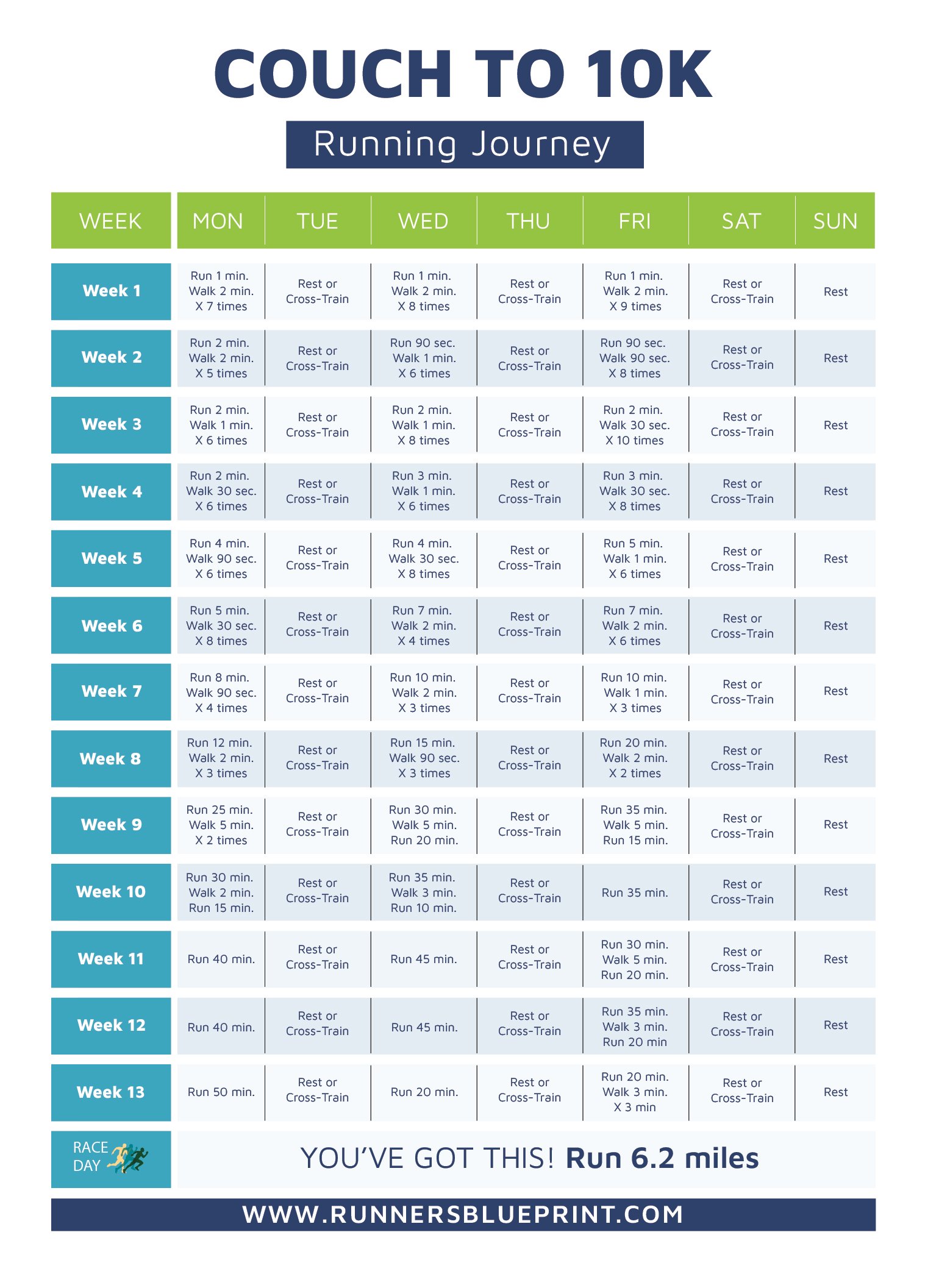Ready to run your first 10K?
6.2 miles might sound daunting, but it’s totally achievable, even if you’re just getting started.
I remember feeling the same uncertainty when I trained for my first 10K. I’d already done a few 5Ks, but the thought of doubling that distance felt like a giant leap.
With a solid plan and the right mindset, you’ll find the 10K is a perfect challenge.
Here’s more good news.
My Couch to 10K program is designed to take you from zero to hero in just 12 weeks. This program builds on the well-known Couch to 5K plan, providing a structured approach that gradually increases running endurance and distance.
Let’s get to it.
What Exactly is a 10K Distance?
You might already know that a 10K stands for 10 kilometers, but how does that translate?
Well, 10K equals about 6.2 miles.
Imagine running around a track 25 times—that’s your 10K.
Sounds like a lot, right? But breaking it down into small goals makes it way more doable.
When I first realized I’d be running over 6 miles, it helped to focus on the “bite-sized” pieces. Focusing on just the next mile or the next corner really helped make the distance feel less intimidating.
As a frame of reference, to complete a 10K distance, you’ll have to :
- Run 50 laps around a standard indoor trackthat’s 200 meters long.
- Run a football field—(109.73 meters) —including the end zone—91.14 times.
- Climb the Empire State Building (443.2 meters high, including antenna) 26.25 times.
- Scale the Eiffel Tower (324 meters tall) 31.25 times.
https://www.youtube.com/watch?v=6FR6yhVTWOc
Here are some useful links on the history of the 10K and some interesting facts.
- 10K Wikipedia Page.
- Things you need to know before your first 10K race.
- 10K racing tips.
- The PRRO official website.
- The IAAF 10K page.
- How to run a 10K in one hour
Now that you’ve got the distance down, let’s talk training.
How Long Will It Take to Train?
If you’re just starting, I’d suggest giving yourself about 12 weeks to train.
For the record, a “beginner” is someone who can already walk comfortably for about an hour or maybe jog a mile.
Don’t stress if 12 weeks sounds long—you’re building endurance and strength.
When I started, I was just like you—wondering if I’d ever get there.
But as you gradually increase distance and speed, you’ll be amazed at how capable you are.
The Average 10K Time For Beginners
How long it takes beginners to finish a 10K depends on things like fitness level, age, and training frequency
According to a survey, the average United States 10K finish results is roughly 53 minutes for men, whereas women cross the finish line at around 63 minutes.
Most beginners will take around 9 to 13 minutes per mile in a 10K. The average untrained beginner might be able to jog/walk the entire 6.2 miles in about 70 to 90 minutes. After a few months of training, the same runner can finish under 60 minutes. Anything under 40 minutes puts you in the serious athlete category.
What’s The Fastest 10K Time?
According to Wikipedia, the current men’s outdoor world-record holder, at the time of writing this, is Joshua Cheptegiy of Uganda at 26:11:00, set on October 7, 2020. That’s a whooping 4:12 a mile.
The women’s world record is 29:01:03 and held by the Ethiopian Letesenbet Gidey on June 8, 2021.
Is a 10K Right for You?
This depends on where you’re starting from. If you can comfortably walk or jog a mile, a 10K is totally doable
But if you’ve been dealing with injuries or health issues, you might want to start smaller, with something like a 5K.
When I had a knee injury a few years back, I had to scale back to shorter distances before building back up.
It’s all about listening to your body.
What Time Should You Aim For?
Now, let’s talk times.
For most beginner runners, you’re looking at somewhere between 70 to 90 minutes to finish a 10K if you’re running at a steady pace. But if you stick with your training, you might cross that finish line closer to an hour.
When I first started, I aimed to complete the race without walking. No fancy time goals, just finishing strong. And you know what? Once I had a few races, I focused on pace and cut my time by a good chunk.
My best advice?
Aim for what suits your current fitness level on race day.
For your first 10K, don’t set a goal that’s too intense.
It’s great to have a goal, but pushing too hard too soon could lead to burnout or injury.
What I’d consider a good 10K is anything around 45 to 50 minutes. I’ve concluded this number by averaging 10K times across various ages and genders worldwide (check the charts below).
To finish a 10K in around 45 to 50 minutes, you’ll need to average about 8 minutes a mile.
Remember that runners with more experience can cross the finish line in under 40 minutes, an average of less than 7 minutes a mile.
10K Race Pace Chart
This chart can help predict your 10K finish time. Remember – This is only a prediction of your maximum potential—glorified fortune-telling—It might not be the reality.
Average 10K Times Based on Age & Gender
Run Repeat completed an interesting study that showed average running speeds and times for men and women divided by age groups. To no one’s surprise, this study reported that age groups correlated drastically with an average 10K time, with younger age groups tending to have a faster average running pace.
The research also found that the average competitive 10K time is around 58 minutes for men in the U.S., whereas the competitive finish time for women stands at 1 hour and 6 minutes.
Relying on the data from the same study, the following charts show averages of 10K times by sex and age in the standard format of hours:minute:seconds.
How to Start Training
One thing I always recommend is starting with a walk-run method. It’s less intimidating and allows your body to get used to the impact of running.
I did this when I first started, and even now when I’m building up to longer distances, I’ll return to it. It’s a lifesaver for both beginners and experienced runners.
You want to feel tired but not exhausted to the point you’re dreading the next run.
And remember—if the training plan feels too fast, slow it down.
The goal is to progress at your own pace.
When I trained for my first 10K, I repeated a few weeks to ensure I was ready. It’s much better to take it slow than risk injury or burnout.
Find The Right Intensity
Let me tell you one of my favorite tips to stay injury-free—find the right intensity. You’re in the sweet spot if you can carry on a conversation while running.
If you’re gasping for breath, it’s time to dial it back. Think of it like this: aim to run at about 65 to 75 percent of your max heart rate—on a scale from 1 to 10, that’s around a 6 or 7.
Rest or Cross Train During 10K Plan
And listen, it’s not just about avoiding injury, it’s also about avoiding burnout. Rest is key, so don’t feel guilty about taking a day off every week—most runners choose Sunday, but do what works for you.
On non-running days, try cross-training. It’s a great way to keep improving your fitness without pounding the pavement. Biking, swimming, strength training, and yoga are all solid options. I’m a big fan of strength training because it does wonders for your running economy and injury prevention.
Focus on strengthening those glutes, hips, hamstrings, quads, and calves, and you’ll be stronger and more resilient
The 10K Training Plan For Beginners
As your running coach, I’m excited to share the Couch to 10K training plan, specially crafted for beginners.
This isn’t just any plan; it’s your roadmap to successfully running a 10K, designed with the utmost care to fit your initial running journey.
As I’ve already explained, we start with the run/walk—or the Galloway method, as many know it.
Over the weeks, as your stamina improves, we’ll gradually decrease walking time and increase running. This method is great for building endurance and crucial for preventing injuries—a common concern for new runners.
I’ve tailored this plan to avoid the pitfalls of increasing mileage too quickly, a mistake I’ve seen in other programs. It’s about progressing at a challenging yet sustainable pace, ensuring you grow stronger without overdoing it.
Note – If this 10K plan is too much for you, try my couch to 8K schedule instead.
Race Day Tips
Here’s where things get exciting—your first race! The night before, lay out all your gear and try to get a good night’s sleep.
I remember how jittery I was the night before my first 10K, but being prepared calmed those nerves.
On race day, start slower than you think you should. It’s so easy to get caught up in the excitement and dash out too fast, but trust me, you’ll thank yourself later when you still have energy for the last couple of miles. My first 10K, I went out way too fast and regretted it by mile 4—don’t be me!
Frequently Asked Questions About Training for a 10K
I know that you have more than one lingering question regarding my couch to 10K plan. Let me address some of these concerns so you can make the most out of the beginner program.
What should I do if I experience pain while training?
If you experience pain during your training, it’s crucial to listen to your body. Do not push through the pain. Instead, take a break and assess the situation. If the pain persists, consult a healthcare professional to identify any underlying issues and ensure you don’t exacerbate any injuries. Remember, addressing pain early can prevent long-term setbacks.
How can I stay motivated during training?
Maintaining motivation throughout your training can be challenging, but here are some strategies to keep your spirits high:
- Set Specific Goals: Break your main goal into smaller, manageable milestones to celebrate along the way.
- Join a Running Group: Connecting with fellow runners can provide a support system and accountability. Sharing experiences and training together can make your runs more enjoyable.
- Track Your Progress: Use a running app or journal to log your workouts and see your improvements over time. Visualizing progress can be incredibly motivating.
How should I handle missed training days?
Life happens, and it’s normal to miss a training session. If you miss a day, don’t stress—just return to your training schedule as planned. If you miss several days, consider repeating a week of training to catch up and allow your body to adapt. Consistency is essential, but it’s also important to be flexible and kind to yourself.
What’s the best way to prevent injuries while training?
Injury prevention is key to a successful training journey. Here are a few tips:
- Warm Up and Cool Down: Always begin your workouts with a proper warm-up and end with a cool-down to help your muscles recover.
- Listen to Your Body: Pay attention to any signs of discomfort or fatigue. Rest when needed and don’t hesitate to adjust your training plan.
- Cross-Train: Incorporating activities like cycling, swimming, or strength training can improve your overall fitness and reduce the risk of overuse injuries.
How long should my long runs be during training?
As you progress in your training, your long runs should gradually increase. Aim to reach a maximum distance of around 6-7 miles before the race. This distance builds endurance without overwhelming your body. Make sure to keep these runs at a conversational pace to enhance your stamina.
What should I eat before training runs?
Eating a balanced meal before your runs can provide the necessary energy. About 1-2 hours prior, consider having a light snack rich in carbohydrates and moderate in protein, such as:
- A banana with almond butter
- Greek yogurt with honey
- A slice of whole-grain toast with avocado
These foods will help fuel your workout and improve your performance.
Join the Conversation!
I want to hear from you! Are you currently training for your first 10K? What has been your biggest challenge so far, and what tips keep you motivated?
Sharing your experiences not only helps you reflect on your journey but also inspires fellow runners who may be facing similar hurdles.
Feel free to drop your thoughts, questions, or personal stories in the comments section below. Whether you’re just starting your training or you’re well on your way, your voice.




I’m excited to start this Couch to 10K plan! I’ve been doing shorter runs, and I wanted a challenge.
Very useful! But I am confused as the 13 week training schedule in the article and in the chart are different. Please help.
In week one, you state that we are to “repeat” the run/walk 7 times…which technically means that we do 8 sets total. Is that what is meant, or are we supposed to perform the run/walk 7 times?
Thanks!
Great advice! I’ve been consistently running my 10Ks just over an hour, and your tips on improving speed and endurance are exactly what I need to break through.
When you say repeat 3 times, does that mean do it once and then another 3 times or 3 times in total?
This was exactly what I needed! I’ve been struggling to run a 10K under an hour, but your tips on pacing and interval training are just what I was missing.
In total
Hi David, do you have a training program for 8weeks for 10k?
What’s your current 10K time?
Thank you for this!
I’ve always wanted to run a 10K but didn’t know where to start. This Couch to 10K plan is perfect! The gradual buildup makes it feel achievable, even for someone like me who’s just starting
I’ve always wanted to break the one-hour mark in a 10K, but I didn’t know how to train for it. Your breakdown of speed work, long runs, and tempo runs gave me the structure I needed.